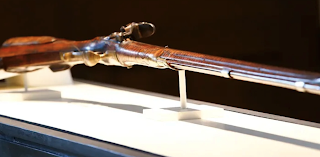The first art theft I ever heard of was that of the Mona Lisa which my father told me about when I was 6 years old, and we visited the Louvre. The theft occurred in August 1911, just a month after he was born -- what better alibi! The caper was pulled by Vincenzo Peruggia, an Italian artist and museum worker, with two cohorts. They hid in a broom closet overnight and before the museum opened the next morning they took the painting off the wall, got it out of its fame and protective glass, and walked out with the painting under a blanket. A bit over two years later Peruggia tried to sell the painting to a dealer who informed the police, and the picture was returned to the museum. In a sense, Peruggia did the Louvre a great favor since the Mona Lisa had not been regarded as such an important picture until its theft, but from then on people flocked to the Louvre to see the painting, and nothing has changed.
Another famous robbery took place in 1990 at the Isabella Stewart Gardner Museum in Boston. It was an audacious heist where two thieves posing as policemen were let in by guards, who were then tied up while the thieves made off with 13 paintings including 3 Rembrandts, a Vermeer and several Degas drawings. The crime has never been solved and the empty frames have been left in place lest the search should escape anyone’s memory. The FBI has estimated the value at about $500 million but today, who knows. Should you see any of the missing works you might want to report it to the FBI because the Museum has offered $10 million to anyone leading to their recovery.
This crime was called to mind again when earlier this year a man was arrested for breaking into the same museum but never entered the building. He smashed a glass door and threw something inside, prompting the police to call the bomb squad. It turned out the man had thrown a blanket-covered painting he had stolen from a private gallery some days earlier. Why? Who knows?
Last year a thief, taking no chances used a sledgehammer to break into a small museum in Laren, the Netherlands, to steal an early van Gogh, “The Parsonage Garden at Neunen”. That was the only picture he took, and he left with it under his arm. The painting had been on loan from a better-known institution, the Groninger. Was he a picky collector or was it a commissioned deal? In any case, the painting has not yet been found though photographs were circulated in September of this year by the unknown perpetrator.
When you look up art theft on the web, 90% of the reports are about paintings but what about the decorative arts? They don’t get ignored, it is just that most people steal for a possible cash reward or hold their loot for ransom or even use it for collateral on loans, and paintings are worth more.
Decorative arts, however, were the focus of one Dr. John Quincy Feller, a professor of history for over 30 years at the University of Scranton. Living in a modest brick apartment on the edge of town, he was the last person you would suspect of larceny. He wrote scholarly books and articles and had access to museums through his friendship with staff members. He clearly would not have had the same eagle eyes on him than unknown visitors. He was proud to have been invited to become a trustee of the Peabody Museum at Harvard University. His particular passions were for porcelain and glass of the 18th and 19th centuries, especially pieces with historical associations. Once in a while he would even lend objects from his purloined collection for exhibitions.
Some of the museums he stole from were the Philadelphia Museum of Art, The Rhode Island School of Design Museum, the Wadsworth Athenaeum and the Ashmolean Museum in Oxford England. A late 18th century porcelain saucer with the great seal of the United States that he had donated to the State Department in Washington D.C. was seized by the FBI. It was one of the roughly one hundred objects the FBI concluded the professor had stolen. He pleaded guilty and was sentenced to 18 months in prison and a $30,000 fine. He stole for his love of objects. How can you hate a guy like that?
One more before I leave you to find your own crime stories. Another thief from Pennsylvania, Thomas Gavin, had gone on his crime spree in the 1960’s and 70’s. His passion was for firearms and found his loot in a dozen East Coast museums. He seems to have also stolen for the love of the objects and not for quick money. He was only recently caught when he raised suspicion as he tried to sell a private collector an American Revolutionary War rifle with an estimated value of $175,000 for $4,000. This says to me that he was trying to sell to survive not for vast profits, or maybe in the end he wanted to get caught and confess. The statute of limitations had expired on most counts and the one that remained when he was sentenced at the end of November this year was trying to sell a stolen article of historical importance. This carries a maximum ten-year sentence and a $50,000 fine. However, since he is now 78 years old, and in a wheelchair, he was given just one day in the slammer. Here is an image by Yong Kim for the Philadelphia Inquirer of the rifle.
There is always more sympathy for one who steals for his love of art and not just for profit!





No comments:
Post a Comment